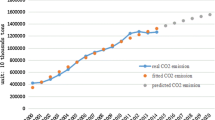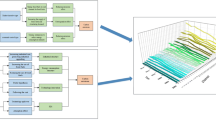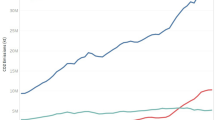Abstract
CO2 emission control is one of the most vital parts of environment management. China owns the largest CO2 emission in the world. For the sake of clarifying China’s emission sharing responsibilities and set emission reduction targets, a considerable number of scholars have worked to project China’s embodied CO2 emission. Single Regional Input–output (SRIO) model is widely used for investigating CO2 emission issues. Considering the ubiquitous time lag of input–output data, entropy optimization model is introduced to estimate SRIO tables. However, the uncertainty in the corresponding model parameters necessarily has a serious impact on the estimation results. To consider the impact of uncertainties, we introduce robust optimization into entropy minimization model for SRIO table estimation. Based on three different uncertainty sets, we constructed three robust entropy minimization models to construct 2016 China’s SRIO tables and calculate China’s embodied CO2 emission based on those tables. The estimation results show that the model based on the ball uncertainty set has the best performance with less uncertainty, while the model based on the budgeted uncertainty set performances more ‘robust’ facing greater uncertainty, which means its performance is less volatile at different levels of uncertainty. Moreover, the embodied carbon emission is predicted to reach 9632.57 Mt CO2. The top emitter is the sector of supply of electricity, heating and water, which accounts for more than 40% of total CO2 emission.




Similar content being viewed by others
Change history
11 January 2021
A Correction to this paper has been published: https://doi.org/10.1007/s11069-020-04486-8
References
Bacharach M (1970) Biproportional matrices and input–output change. Cambridge University Press, Cambridge
Balster A, Friedrich H (2019) Dynamic freight flow modelling for risk evaluation in food supply. Transp Res E-Log 121:4–22
Ben-Tal A, Goryashko A, Guslitzer E, Nemirovski A (2004) Adjustable robust solutions of uncertain linear programs. Math Program 99(2):351–376
Beynon MJ, Munday M, Roberts A (2005) Ranking sectors using fuzzy output multipliers. Econ Syst Res 17(3):237–253
Buckley JJ (1989) Fuzzy input–output analysis. Eur J Oper Res 39:54–60
Cai WQ, Song XM, Zhang PF, Xin ZC, Zhou Y, Wang YT, Wei WD (2020) Carbon emissions and driving forces of an island economy: a case study of Chongming Island, China. J Clean Prod 254:120028
Cascetta E, Marzano V, Papola A (2008) Multi-regional input–output models for freight demand simulation at a national level. In: Ben-Akiva ME, Meersman H, van de Voorde E (eds) Recent developments in transport modelling: lessons for the freight sector. Emerald Group Publishing, Bingley
Chen S, Chen B, Su M (2015) Technology: Nonzero-sum relationships in mitigating urban carbon emissions: a dynamic network. Simulation 49:11594
Druckman A, Jackson T (2009) The carbon footprint of UK households 1990–2004: a socio-economically disaggregated, quasi-multiregional input–output model. Ecol Econ 68(7):2066–2077
Golan A, Judge GG, Miller D (1996) Maximum entropy econometrics. Staff Gen Rese Pap Arch 11(2):331–333
Guan D, Hubacek K, Weber CL, Peters GP, Reiner DM (2008) The drivers of Chinese CO2 emissions from 1980 to 2030. Glob Environ Change 18(4):626–634
Han YF, Qu SJ, Wu Z, Huang RP (2019) Robust consensus models based on minimum cost with an application to marketing plan. J Intell Fuzzy Syst 37(4):5655–5668
Harrigan F, Buchanan I (1980) A quadratic programming approach to input–output estimation and simulation. J Reg Sci 24:339–358
Hawkins T, Hendrickson C, Higgins C, Matthews HS, Suh S (2007) A mixed-unit input–output model for environmental life-cycle assessment and material flow analysis. Environ Sci Technol 41:1024–1031
Hiramatsu T, Inoue H, Kato Y (2016) Estimation of interregional input–output table using hybrid algorithm of the RAS method and real-coded genetic algorithm. Transp Res E-Log 95:385–402
Huang RP, Qu SJ, Yang XG, Liu ZM (2019) Multi-stage distributionally robust optimization with risk aversion. J Ind Manag Optim. https://doi.org/10.3934/jimo.2019109
Jackson RW, Murray AT (2004) Alternative input–output matrix updating formulations. Econ Syst Res 16:135–148
Ji Y, Qu SJ, Wu Z, Liu ZM (2020) A fuzzy-robust weighted approach for multicriteria bilevel games. IEEE Trans Ind Inform 16(8):5369–5376
Lahr ML (1998) A strategy for producing hybrid regional input–output tables. In: 39th annual north american meetings of the regional science association, Chicago, 1992, and the 12, 1–31
Lahr ML (2001) A strategy for producing hybrid regional input–output tables. In: Lahr ML, Dietzenbacher E (eds) Input–output analysis: frontiers and extensions. Palgrave Macmillan, London, pp 211–242
Lenzen M (1998) Primary energy and greenhouse gases embodied in Australian final consumption: an input–output analysis. Energy Pol 26(6):495–506
Lenzen M, Pade LL, Munksgaard J (2004) CO2 multipliers in multi-region input–output models. Econ Syst Res 16(4):391–412
Leontief W (1970) Environmental repercussions and the economic structure: an input-output approach. Rev Econ Stat 52(3):262
Li JS, Wei WD, Wei Z, Guo Y, Chen B (2019) How green transition of energy system impacts China’s mercury emissions. Earths Future. https://doi.org/10.1029/2019EF001269
Mattila JK, Luukka P (2009) Solving Leontief input–output model with fuzzy entries. In: FUZZ-IEEE 2009, ieee international conference on fuzzy systems, Jeju Island, Korea, 20-24 August 2009, Proceedings. IEEE
McGregor PG, Swales JK, Turner K (2008) The CO2 trade balance between Scotland and the rest of the UK: performing a multi-regional environmental input–output analysis with limited data. Ecol Econ 66:662–673
Morillas A, Robles L, Díaz B (2011) I-O coefficients importance: a fuzzy logic approach. Int J Uncertain Fuzziness Knowl Based Syst 19(6):1013–1031
NBS (2017) China energy statistical yearbook. 2006–2012, China. Statistics Press, Beijing
NBS (2018a) China statistical yearbook 2018, China. Statistics Press, Beijing
NBS (2018b) 2015 Input–output table of China. China Statistics Press, Beijing
Ottomanelli M, Caggiani L, Dell’Orco M (2014) Handling uncertainty in multi regional input–output models by entropy maximization and fuzzy programming. Transp Res E-Log 11:159–172
Park JY, Gordon P, Moore JE II, Richardson HV (2009) A two-step approach to estimating state-to-state commodity trade flows. Ann Reg Sci 43:1033–1072
Peters GP, Hertwich EG (2008) CO2 embodied in international trade with implications for global climate policy. Environ Sci Technol 42(5):1401–1407
Qu SJ, Han YF, Wu Z, Hassan R (2020) Group Decis Negot. https://doi.org/10.1007/s10726-020-09707-w
Rey SJ, West GR, Janikas MV (2004) Uncertainty in integrated regional models. Econ Syst Res 16(3):259–277
Roy JR (2004) Regional input–output analysis, data and uncertainty. Ann Reg Sci 38(3):397–412
Shan Y, Guan D, Zheng H (2018) China CO2 emission accounts 1997–2015. Sci Data 5:170201
Tan RR, Aviso KB, Barilea IU, Culaba AB, Cruz JB (2012) A fuzzy multi-regional input–output optimization model for biomass production and trade under resource and footprint constraints. Appl Energy 90(1):154–160
Tavasszy L, Friedrich H (2019) Supply chain elements in freight transport modelling. Transp Res E-Log 121:1–3
Turner K, Lenzen M, Wiedmann T, Barrett J (2007) Examining the global environmental impact of regional consumption activities: Part 1: a technical note on combining input–output and ecological footprint analysis. Ecol Econ 62:37–44
Wang XC (2016) Stochastic resource allocation for containerized cargo transportation networks when capacities are uncertain. Transp Res E-Log 93:334–357
Wei WD, Zhang PF, Yao MT, Xue M, Miao JW, Liu B, Wang F (2020a) Multi-scope electricity-related carbon emissions accounting: a case study of Shanghai. J Clean Prod 252:119789
Wei WD, Hao SJ, Yao MT, Chen W, Wang SS, Wang ZY, Wang Y, Zhang PF (2020b) Unbalanced economic benefits and the electricity-related carbon emissions embodied in China’s interprovincial trade. J Environ Manage 263:110390
Wiedmann T, Wilting HC, Lenzen M, Lutter S, Palm V (2011) Quo Vadis MRIO? Methodological, data and institutional requirements for multi-region input–output analysis. Ecol Econ 70(11):1937–1945
Wilting HC (2012) Sensitivity and uncertainty analysis in MRIO modelling; Some empirical results with regard to the Dutch Carbon footprint. Econ Syst Res 24(2):141–171
Zhang PF, Cao WQ, Yao MT, Wang ZY, Yang LZ, Wei WD (2020) Urban carbon emissions associated with electricity consumption in Beijing and the driving factors. Appl Energy 275:115425
Author information
Authors and Affiliations
Corresponding author
Ethics declarations
Conflict of interest
The authors declared that there is no conflict of interest in this paper.
Additional information
Publisher's Note
Springer Nature remains neutral with regard to jurisdictional claims in published maps and institutional affiliations.
Rights and permissions
About this article
Cite this article
Qu, S., Cai, H., Xu, D. et al. Uncertainty in the prediction and management of CO2 emissions: a robust minimum entropy approach. Nat Hazards 107, 2419–2438 (2021). https://doi.org/10.1007/s11069-020-04434-6
Received:
Accepted:
Published:
Issue Date:
DOI: https://doi.org/10.1007/s11069-020-04434-6




